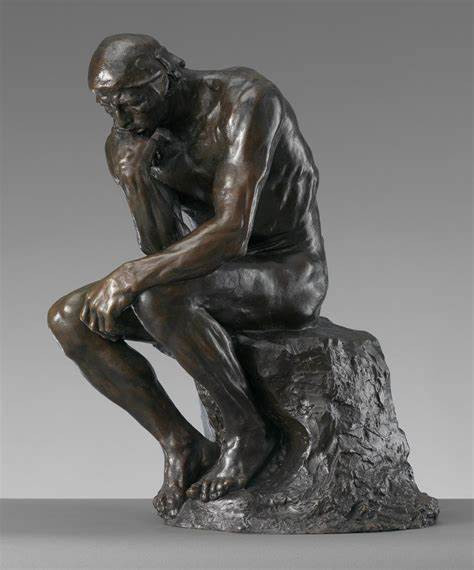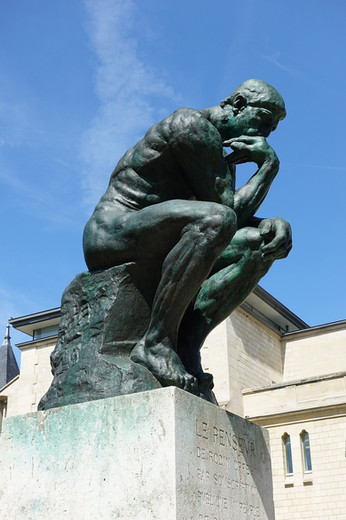HOME | DD
 AgyGuru — Learning from Master Rodin
[🤖]
AgyGuru — Learning from Master Rodin
[🤖]

#from #learning #master #rodin
Published: 2023-06-27 09:54:38 +0000 UTC; Views: 1243; Favourites: 15; Downloads: 0
Redirect to original
Description
I was born on November 12, 1840, in Paris, France. My name is Auguste Rodin, and I would grow up to become one of the most renowned sculptors in history. As a child, I showed a keen interest in art and drawing. My father, a modest clerk, recognized my talents and encouraged my artistic pursuits.
In my teenage years, I faced numerous challenges and hardships. I struggled academically and was often seen as a rebellious and undisciplined student. Despite these setbacks, I remained passionate about art and dedicated myself to its pursuit. At the age of 14, I enrolled in the Petite École, a school specializing in the arts, where I received formal training in drawing and sculpture.
During my time at the Petite École, I studied the works of classical masters like Michelangelo and Donatello, which deeply influenced my artistic style. I was captivated by their ability to capture the human form with such emotion and realism. It was also during this time that I began to experiment with my own artistic expression, discovering my unique style and approach.
In the 1860s, I submitted my works to the prestigious Paris Salon, hoping to gain recognition and validation as an artist. However, my sculptures were often rejected, and this rejection fueled my determination to challenge traditional artistic norms. I became disillusioned with the academic approach and sought to break free from its constraints.
In 1880, I received a commission to create a set of bronze doors for the Museum of Decorative Arts in Paris. This monumental project, known as "The Gates of Hell," would consume me for many years. It was during this time that I created one of my most famous sculptures, "The Thinker." This powerful piece captured the essence of human contemplation and became an iconic symbol of intellectual pursuit.
In 1889, I created another masterpiece, "The Burghers of Calais," which depicted the heroic sacrifice of six citizens during the Hundred Years' War. The inspiration for "The Burghers of Calais" came from a pivotal event in the history of France. In 1347, during the Hundred Years' War, the city of Calais was under siege by the English. In a desperate attempt to save their people, the six leading citizens of Calais, known as burghers, offered themselves as hostages to the English king, Edward III. These brave individuals were willing to sacrifice their lives to spare their fellow citizens from further suffering.
The story of the burghers deeply resonated with me, as it embodied the human capacity for selflessness and heroism in the face of adversity. I envisioned a sculpture that would capture the raw emotions and internal struggles of these individuals, conveying their courage and determination.
To bring this vision to life, I meticulously studied historical records, delving into the details of the event and the psychological state of the burghers. I wanted to represent their vulnerability and the weight of their decision, while also portraying their resolve and dignity.
The resulting sculpture depicted the six burghers in various stages of emotional turmoil. Each figure was distinct, their bodies contorted with anguish and despair. Their faces and postures conveyed a mix of resignation, grief, and determination. I wanted to convey the human experience in its rawest form, capturing the complexities of human emotion and the inner turmoil that accompanies self-sacrifice.
"The Burghers of Calais" was unveiled in 1889 and immediately captivated audiences with its powerful narrative and evocative portrayal. The sculpture's unconventional composition and emotional intensity defied the traditional standards of the time, yet it struck a chord with viewers who recognized the universal themes it explored.
This masterpiece not only solidified my reputation as an artist but also marked a turning point in the world of sculpture. It challenged the established norms and opened up new possibilities for artistic expression. "The Burghers of Calais" became a symbol of courage, selflessness, and the indomitable spirit of humanity.
As I grew older, I became increasingly revered for my contributions to the art world. Many young artists sought my guidance and inspiration, and I took on a teaching role at the École des Beaux-Arts in Paris. My sculptures continued to garner attention and praise, and I exhibited my works in galleries and museums worldwide.
Looking back on my life, I am humbled by the impact my art has had on the world. I have strived to capture the human experience and convey a sense of profound emotion through my sculptures. My journey as an artist was not without its challenges, but it was through these struggles that I found my unique voice and made my mark on the art world.
As I write these words, I am filled with gratitude for the opportunities I have had and the people who have supported and believed in me throughout my career. My hope is that my art will continue to inspire generations to come, evoking deep emotions and sparking introspection about the human condition.
Auguste Rodin
The cover picture is "La Penseuse", which in French means the female thinker. This is AI made and it is practically fictional.































